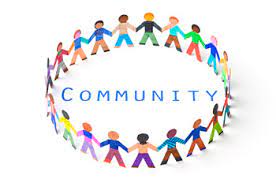The Power of Community
Community is a fundamental aspect of human society, bringing people together to share experiences, support each other, and create a sense of belonging. Whether it’s a local neighborhood, an online group, or a workplace team, communities play a crucial role in shaping our lives.
One of the key benefits of being part of a community is the opportunity for connection. Through shared interests, values, or goals, individuals can form bonds that provide emotional support and companionship. This sense of belonging can help combat feelings of loneliness and isolation, fostering a sense of unity and togetherness.
Communities also offer a platform for collaboration and collective action. By pooling resources, knowledge, and skills, members can work together to achieve common objectives or address shared challenges. This collaborative spirit not only leads to more effective problem-solving but also promotes innovation and creativity.
Moreover, communities provide a space for learning and personal growth. Interacting with diverse perspectives and experiences within a community can broaden one’s horizons, challenge assumptions, and stimulate intellectual curiosity. Through constructive feedback and mentorship from fellow community members, individuals can develop new skills and expand their knowledge base.
Ultimately, the power of community lies in its ability to create positive change and impact both individuals and society as a whole. By fostering connections, collaboration, learning, and support, communities serve as catalysts for personal development, social cohesion, and collective progress.
The Benefits of Community: Emotional Support, Collaboration, Diversity, Growth, Unity, and Positive Impact
- Provides emotional support and a sense of belonging
- Fosters collaboration and collective action
- Encourages diversity of perspectives and experiences
- Facilitates learning and personal growth
- Strengthens social cohesion and unity
- Creates opportunities for positive change and impact
Challenges and Drawbacks of Community Dynamics
- Conflict and disagreements can arise within a community, leading to tension and division among members.
- Cliques or exclusive groups may form within a community, creating feelings of exclusion or favoritism.
- Community expectations and norms may limit individual freedom and expression, stifling diversity of thought.
- Communities can sometimes perpetuate stereotypes or biases, reinforcing social inequalities.
- In some cases, communities may become insular or closed off to outsiders, hindering opportunities for growth and new perspectives.
- Negative behaviors or attitudes within a community can spread quickly and impact the overall culture in detrimental ways.
Provides emotional support and a sense of belonging
Being part of a community offers invaluable emotional support and a profound sense of belonging to individuals. In times of joy or hardship, having a network of people who understand, empathize, and stand by you can make all the difference. The shared experiences, camaraderie, and mutual care within a community create a nurturing environment where individuals feel accepted, valued, and connected. This sense of belonging not only boosts mental well-being but also strengthens relationships and fosters a deeper sense of purpose and identity among community members.
Fosters collaboration and collective action
Communities play a vital role in fostering collaboration and collective action among individuals with shared interests or goals. By coming together within a community, people can pool their resources, knowledge, and skills to work towards common objectives or address mutual challenges. This collaborative spirit not only enhances problem-solving effectiveness but also encourages innovation and creativity. Through coordinated efforts and mutual support, community members can amplify their impact and achieve outcomes that would be difficult or impossible to accomplish alone.
Encourages diversity of perspectives and experiences
Communities serve as vibrant hubs that encourage a diversity of perspectives and experiences among their members. By bringing together individuals from various backgrounds, cultures, and beliefs, communities create a rich tapestry of ideas and insights. This diversity fosters open dialogue, challenges preconceived notions, and promotes understanding and empathy among community members. Through exposure to different viewpoints and lived experiences, individuals within a community have the opportunity to broaden their horizons, expand their knowledge, and cultivate a more inclusive and tolerant mindset. Ultimately, the encouragement of diverse perspectives within a community leads to greater creativity, innovation, and collective growth.
Facilitates learning and personal growth
Being part of a community facilitates learning and personal growth by providing a diverse and supportive environment for individuals to expand their knowledge, skills, and perspectives. Interacting with others who offer unique insights and experiences challenges individuals to think critically, learn from different viewpoints, and broaden their horizons. Constructive feedback, mentorship, and collaborative opportunities within a community empower individuals to develop new talents, enhance existing abilities, and embark on a journey of continuous self-improvement. Through the exchange of ideas and the sharing of expertise, communities serve as invaluable platforms for fostering learning and personal growth among their members.
Strengthens social cohesion and unity
Community strengthens social cohesion and unity by bringing people together around shared values, interests, or goals. Through regular interactions and mutual support within a community, individuals develop a sense of belonging and connection to one another. This shared bond fosters empathy, understanding, and a collective identity that transcends individual differences. By promoting inclusivity and solidarity, communities create a cohesive social fabric that encourages cooperation, respect, and harmony among its members. This sense of unity not only enhances the well-being of individuals but also contributes to building a more resilient and harmonious society as a whole.
Creates opportunities for positive change and impact
Communities serve as catalysts for positive change and impactful outcomes by providing a platform for individuals to come together, collaborate, and address common goals or challenges. Through collective action and shared efforts, communities can drive meaningful initiatives, promote social awareness, and effect positive transformations in various aspects of society. By harnessing the combined strengths and resources of its members, a community can create lasting change that benefits not only its constituents but also the broader community at large.
Conflict and disagreements can arise within a community, leading to tension and division among members.
Conflict and disagreements can be a significant con of community life, as they have the potential to disrupt harmony and create rifts among members. When differing opinions, values, or interests clash within a community, it can lead to tension, animosity, and even division. Resolving conflicts effectively requires open communication, empathy, and compromise from all parties involved. Failure to address conflicts promptly and constructively can weaken the community’s cohesion and erode trust among its members. Managing conflict is essential for maintaining a healthy and thriving community where diverse perspectives are respected, and disagreements are handled with maturity and respect.
Cliques or exclusive groups may form within a community, creating feelings of exclusion or favoritism.
Within a community, one significant con that can arise is the formation of cliques or exclusive groups. When certain members band together, excluding others based on arbitrary criteria or personal preferences, it can lead to feelings of exclusion and favoritism among those left out. This behavior can create divisions within the community, hindering collaboration and fostering an atmosphere of inequality. Cliques may limit opportunities for meaningful interaction and participation for individuals who do not belong to these exclusive groups, ultimately undermining the sense of unity and inclusivity that a community should strive to uphold. Addressing and mitigating cliques within a community is essential to ensure that all members feel valued, respected, and included in the collective experience.
Community expectations and norms may limit individual freedom and expression, stifling diversity of thought.
Community expectations and norms can sometimes act as a double-edged sword, as they have the potential to restrict individual freedom and expression, leading to a stifling of diversity of thought. When communities uphold rigid standards or conformist behaviors, individuals may feel pressured to adhere to these norms, even if it means suppressing their unique perspectives or unconventional ideas. This conformity can hinder innovation, creativity, and critical thinking, ultimately limiting the richness and depth of discourse within the community. Embracing diversity of thought requires communities to foster an environment where individuals feel empowered to express themselves authentically without fear of judgment or reprisal, promoting a more inclusive and dynamic exchange of ideas.
Communities can sometimes perpetuate stereotypes or biases, reinforcing social inequalities.
Communities, while often celebrated for their ability to foster connection and support, can also inadvertently perpetuate stereotypes or biases, reinforcing social inequalities. In tightly-knit groups, there may be a tendency to uphold traditional norms or beliefs that marginalize certain individuals based on factors such as race, gender, or socioeconomic status. This can create barriers to inclusion and diversity within the community, limiting opportunities for meaningful interaction and mutual understanding. By failing to challenge ingrained stereotypes and biases, communities risk perpetuating systemic inequalities and hindering progress towards a more inclusive and equitable society.
In some cases, communities may become insular or closed off to outsiders, hindering opportunities for growth and new perspectives.
In certain instances, communities can develop a tendency to become insular and exclusive, creating barriers that limit interactions with outsiders and impede the influx of fresh ideas and perspectives. This closed-off mentality can stifle innovation, hinder diversity, and foster a sense of exclusivity that may alienate individuals who do not fit within the established norms of the community. As a result, the community may miss out on valuable opportunities for growth, learning, and collaboration that come from embracing diversity and engaging with a broader range of viewpoints.
Negative behaviors or attitudes within a community can spread quickly and impact the overall culture in detrimental ways.
Negative behaviors or attitudes within a community can spread quickly and have a detrimental impact on the overall culture. When unchecked, toxic behaviors such as gossip, bullying, or discrimination can create a hostile environment that erodes trust, damages relationships, and undermines the sense of unity within the community. These negative patterns can perpetuate and become normalized if not addressed promptly, leading to a toxic culture that hinders collaboration, stifles creativity, and drives away potential members. It is essential for communities to actively promote positive values, enforce boundaries against harmful behaviors, and encourage open communication to prevent the spread of negativity and maintain a healthy and supportive environment for all members.

